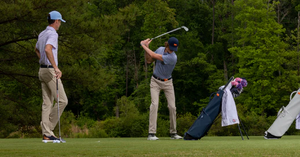Slice vs. Hook in Golf
To the untrained eye, a slice and hook in golf can look identical and usually involve the ball sailing way left or right of the intended target. High-level golfers might use slices or hooks to escape from certain tricky situations, but more often than not, they're shots followed by disgruntled muttering. Let's look at these two hugely frustrating additions to our golf games.
What is a Slice in Golf?
A slice is a golf shot where the ball curves dramatically in a left-to-right direction (for right-handed golfers) and is one of the most common problems amateurs face. The slice is typically caused by an open clubface at the point of impact, coupled with an outside-to-inside swing path - meaning the ball's flight starts left of the target before curving right, often ending up well off the intended path.
What is a Hook in Golf?
On the other hand, a hook results in a significant right-to-left curve for a right-handed golfer. This occurs when the clubface is closed relative to the swing path at impact. Hooks are less common than slices but can be equally anger-inducing when they happen. The ball usually starts on the right side of the target and then curves sharply to the left.
A controlled hook is known as a 'draw' and can be useful to get out of a tight situation. Who will ever forget Bubba Watson's outrageous draw shot on the second hole of a sudden-death playoff against Louis Oosthuizen at the 2012 Masters? A one in a one-in-a-million shot - one of the most iconic moments in golf history. But let's not get ahead of ourselves.
What Is the Difference Between a Slice and a Hook?
Slices and hooks both involve skewing the ball either left or right, but the main difference is the direction of the ball's curvature. A slice travels from left to right, while a hook moves in the opposite direction from right to left. For left-handed players, the opposite is true (slice is right to left and hook left to right.)
While both are often the result of improper grip, stance, or swing path, the resulting hit means the ball careens off course in opposite directions.
Common Causes of Slices and Hooks: How to Avoid
Grip Issues
In a slice, it's common for the grip to be too weak, with the hands turned too far left on the club. The opposite is often true for a hook – a grip that's too strong with the hands turned too far right. Adjusting the grip to a more neutral position can help alleviate these issues.
Swing Path Problems
Getting your swing path wrong affects ball flight. If you watch a professional golfer, their swing is clean and crisp, with follow-through that follows the projected line of the ball until the club curves over your shoulder.
When the club path skews either left or right, you have a swing problem that can easily contribute to a slice or a hook, depending on which way it goes.
An outside-to-inside swing path often causes slices, while an inside-to-outside path can lead to hooks. Practicing a straighter swing path with the help of drills or a golf instructor can help correct this.
Clubface Alignment
An open clubface at impact is a common cause of a slice, and a closed clubface can result in a hook. You can practice squaring by focusing on the position of the clubface throughout the swing and taking your time.
Often, people new to the game want to hit the ball as hard and far as possible. It's much better to slow your swing down to perfect both your swing path and clubface alignment in the early stages. Otherwise, you'll be venturing into that distant rough for the foreseeable future.
Body Alignment
Improper body alignment can also contribute to slicing or hooking the ball. It's common to see golfers try to alter their alignment in response to problems in their game - ironically, often because of slicing or hooking too much. Here's a quick checklist to make sure you're in the correct shape:
- Relax - Shake out that tension!
- Choose your direction. If it helps, place a club on the floor that runs slightly parallel to the left of where you want the ball to land. This is your marker for where you should stand.
- Ensure your feet, forearms, hips, and shoulders are correctly aligned parallel to the target line. Additionally, each should align with its partner; for example, both shoulders should be in line, and hips should be nice and straight.
- Take a deep breath and swing.
Frequently Asked Questions
Would You Rather Hook or Slice?
This depends on the golfer and their overall strategy - but usually neither. Generally, a hook is considered more controllable and less damaging than a slice. A controlled hook or 'draw' can even be a good thing, as it often results in more distance.
Why Did I Go From Slicing To Hooking?
Transitioning from slicing to hooking usually indicates a change in swing dynamics, often from correcting one extreme to another. This could be a result of adjusting your grip or swing path. It's important to find a balance to avoid both extremes.
Final Thoughts
Understanding the differences between a slice and a hook in golf is crucial for any player looking to improve their game. Both shots result from technical errors in the swing, grip, or alignment and can make you want to stamp around in a rage, but both are also easily fixable with the proper attention. With some practice and possibly professional guidance, there's no reason a motivated golfer can't rectify these issues quickly.
When it comes together, and you see the ball sail in the direction you were hoping, it's an incredible feeling - you're really learning the game of golf. For all your golf needs, whether apparel or equipment, check out Stitch Golf. Look your best out on the green!



